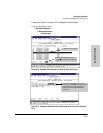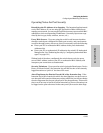
6-131
Configuring the Switch
Class of Service (CoS): Managing Bandwidth More Effectively
Configuring the Switch
CoS is implemented in the form of rules or policies that are configured on the
switch. While you can use CoS to prioritize only the outbound traffic moving
through the switch, you derive the maximum benefit by using CoS in an 802.1Q
VLAN environment (with 802.1p priority tags), where CoS can set priorities
that are supported by downstream devices.
By management through prioritizing, CoS supports growth of traffic on the
network while optimizing the use of existing resources—and delaying the
need for further investments in equipment and services. That is, CoS enables
you to:
■ Specify which traffic has higher or lower priority, regardless of current
network bandwidth or the relative priority setting of the traffic when it is
received on the switch.
■ Change (upgrade or downgrade) the priority of outbound traffic.
■ Override “illegal” packet priorities set by upstream devices or applications
that use 802.1Q VLAN tagging with 802.1p priority tags.
■ Avoid or delay the need to add higher-cost NICs (network interface cards)
to implement prioritizing. (Instead, control priority through network
policy.)
Definitions
Term Use in This Document
downstream
device
A device linked directly or indirectly to an outbound switch port. That is, the switch sends traffic to
downstream devices.
inbound port Any port on the switch through which traffic enters the switch.
outbound port Any port on the switch through which traffic leaves the switch.
outbound port
queue
For any port, a buffer that holds outbound traffic until it can leave the switch through that port. There
is a “high priority” queue and a “normal priority” queue for each port in the switch. Traffic in a port’s
high priority queue leaves the switch before any traffic in the port’s normal priority queue.
precedence bits The upper three bits in the Type of Service (ToS) field of an IP packet.
upstream
device
A device linked directly or indirectly to an inbound switch port. That is, the switch receives traffic from
upstream devices.
802.1p priority A traffic priority setting carried only in packets in 802.1Q tagged VLANs. This setting can be from 0 - 7.
802.1Q tagged
VLAN
A virtual LAN (VLAN) that complies with the 802.1Q standard and is configured as “tagged”. (For more
on VLANs, see page 6-51.)


















